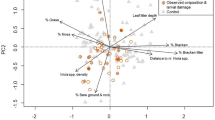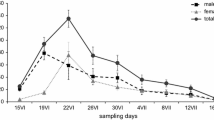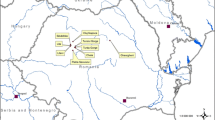Summary
The adult populations of threePieris butterflies,P. rapae, P. melete andP. napi, were studied in an area of their coexistence throughout the flight seasons by using the mark-and-recapture method. The study area, about 3×1.5 km, was set up in a farm village surrounded by the mountainous area in Inabu, Aichi Prefecture.
The habitats were qualified by the four factors, i. e., oviposition plants, adult nector plants, roosting-sites and light conditions. BetweenP. rapae andP. napi, there were sharp differences with regards to overall habitat preferences.P. melete had the widest preferences for all the habitat resources, which overlapped greately with requirements ofP. rapae andP. napi. P. melete andP. rapae showed similar preferences for oviposition plants, but the former preferred shaded habitats while the latter preferred sunny places.P. melete andP. napi, having similar preferences for shaded situations, showed differences in the preferences for oviposition plants. Moreover, three species ofPieris were different in their preferences for adult nector plants. Thus, they were more likely to partition habitat resources rather than competing for them.
The habitat structures of each species in respect of time, space and stability to weather changes were much different each other in the same area. The habitat ofP. rapae was temporary, localized and unstable. While, that ofP. melete was more permanent, widespread and stable than that ofP. rapae. P. napi seemed to live in the intermediate habitat, i. e., permanent, localized and stable one.
Similar content being viewed by others
References
Ehrlich, P. R., R. R. White, M. C. Singer, S. W. Mckechnie andL. E. Gilbert (1975) Checkerspot butterflies: a historical perspective.Science 188: 221–228.
Elton, C. (1949) Population interspersion: An essay on animal community patterns.J. Ecol. 37: 1–23.
Fukuda, H., T. Kuzuya, A. Takahashi, M. Takahashi, B. Tanaka andM. Wakabayashi (1972) Butterflies,Insect's life in Japan 3. Hoikusha, Osaka 278 pp. (In Japanese)
Gilbert, L. P. andM. C. Singer (1975) Butterfly ecology.Ann. Rev. Ecol. and Syst. 6: 365–397.
Hiura I. (1968) A history of the genusPieris.Konchū to Shizen. 3: (5): 9–15. (In Japanese)
Hiura I. (1973)Butterflies acrossing over the sea. Aoki-shobō, Tokyo 200 pp. (In Japanese)
Hutchinson, G. E. (1957) Concluding Remarks. Cold Spring Harbor Symp.Quant. Biol. 22: 415–427.
Hutchinson, G. E. (1965)The Ecological Theatre and the Evolutionary Play. Yale Univ. Press, New Haven, Conn.
Iwao, S. (1970) Dynamics of numbers of a phytophagous lady-beetle,Epilachna vigintioctomaculata living in patchily distributed habitats.Proc. Adv. Study Inst. Dynamics Numbers Popul. (Oosterbeek) 129–147.
Iwao, S. (1975) Life-table analysis: its usefulness and limitations. Abstract Sugadaira Symp.Kotaigun Seitai Gakkai Kaiho 26, 27: 7–9. (In Japanese)
McFarland, N. (1971) A specialized case of communal roosting inPieris rapae (Pieridae).J. Lepid. Soc. 25: 144–145.
Osada, M. andY. Itô (1974) Population dynamics ofPieris rapae crucivora Boisduval (Lepidoptera: Pieridae) an introduced insect pest in Okinawa. I. Winter-spring generations.Jap. J. appl. Ent. Zool. 18: 65–72. (In Japanese with English summary)
Peet, R. K. (1974) The measurement of species diversity.Ann. Rev. Ecol. and Syst. 5: 285–307.
Petersen, B. (1954) Egg-laying and habitat selection in somePieris species.Entomol. Tidskr. 74: 194–203.
Simpson, E. H. (1949) Measurement of diversity.Nature 163: 688.
Southwood, T. R. E. (1977) Habitat, the templet for ecological strategies?.J. Anim. Ecol. 46: 337–365.
Takahashi, M. (1975)Pieris napi japonica Shirōzu in Shizuoka Prefecture and southern part of Yamanashi Prefecture.Suruga no Konchu 89: 2593–2614. (In Japanese)
Author information
Authors and Affiliations
Rights and permissions
About this article
Cite this article
Ohsaki, N. Comparative population studies of threePieris butterflies,P. rapae, P. melete andP. napi, living in the same area. Res Popul Ecol 20, 278–296 (1979). https://doi.org/10.1007/BF02512633
Issue Date:
DOI: https://doi.org/10.1007/BF02512633




